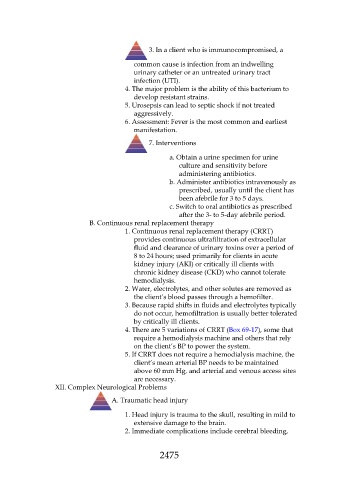Page 2475 - Saunders Comprehensive Review For NCLEX-RN
P. 2475
3. In a client who is immunocompromised, a
common cause is infection from an indwelling
urinary catheter or an untreated urinary tract
infection (UTI).
4. The major problem is the ability of this bacterium to
develop resistant strains.
5. Urosepsis can lead to septic shock if not treated
aggressively.
6. Assessment: Fever is the most common and earliest
manifestation.
7. Interventions
a. Obtain a urine specimen for urine
culture and sensitivity before
administering antibiotics.
b. Administer antibiotics intravenously as
prescribed, usually until the client has
been afebrile for 3 to 5 days.
c. Switch to oral antibiotics as prescribed
after the 3- to 5-day afebrile period.
B. Continuous renal replacement therapy
1. Continuous renal replacement therapy (CRRT)
provides continuous ultrafiltration of extracellular
fluid and clearance of urinary toxins over a period of
8 to 24 hours; used primarily for clients in acute
kidney injury (AKI) or critically ill clients with
chronic kidney disease (CKD) who cannot tolerate
hemodialysis.
2. Water, electrolytes, and other solutes are removed as
the client’s blood passes through a hemofilter.
3. Because rapid shifts in fluids and electrolytes typically
do not occur, hemofiltration is usually better tolerated
by critically ill clients.
4. There are 5 variations of CRRT (Box 69-17), some that
require a hemodialysis machine and others that rely
on the client’s BP to power the system.
5. If CRRT does not require a hemodialysis machine, the
client’s mean arterial BP needs to be maintained
above 60 mm Hg, and arterial and venous access sites
are necessary.
XII. Complex Neurological Problems
A. Traumatic head injury
1. Head injury is trauma to the skull, resulting in mild to
extensive damage to the brain.
2. Immediate complications include cerebral bleeding,
2475

